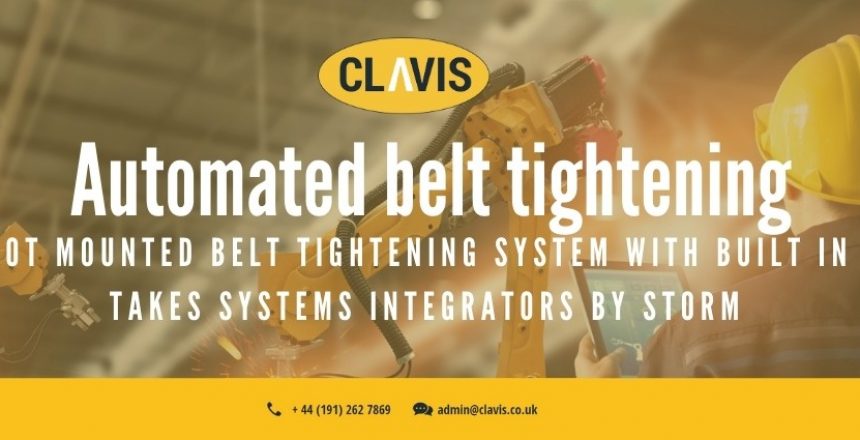It is time for that perfect photo; the one that portrays a life changing moment perfectly. With phone or camera in hand, you take your first selfie as a married couple or capture your child’s first football match or University graduation. But, if that photo is a blur, then the moment is lost.
This situation will be familiar to any engineer who has ever used a handheld instrument to take a measurement — and then wished they had used a mount when the data is found to be inaccurate. It is for this reason that Clavis has introduced a purpose designed series of robot-mounted belt tension equipment with built in programmable logic controllers (PLCs).
The Clavis belt tension equipment is already the automotive industry standard for belt tension measurement, but it is also ideal in any application where the product features a belt drive. This new system is the result of feedback from systems integrators who want to position the equipment on a secure and mobile mount, such as a robot or actuator, to further improve its accuracy.
Three key benefits of the new system
- Robot mounted – no more inaccurate readings due to the user’s hands shaking
- Integrated PLC – Opens up a world of control and data applications
- Robot mounting means belt tension testing can keep up with the pace of the rest of the line
How does it work?
The Clavis sensor head uses vibration in the belt to determine tension, by gently plucking or tapping it. As the tension in the belt increases, so does the frequency of the vibration, just like it would on a guitar or any other stringed instrument. The equipment can then display the result in Hertz, Newtons, pounds-force or kilogram-force (KgF).
As a result, the basic unit, even without robot mount, is already very flexible and can be easily positioned on any application.
The optical unit is ideal when there is a physical restriction because it doesn’t require contact and can take measurements from up to 50 mm away.
Benefits of the integrated PLCs
The instrument can be supplied with a PLC from any manufacturer, and is already found paired with SIEMENS, Mitsubishi and Allen Bradley models. As a result, it works seamlessly in your plant, no matter what protocols and devices you currently employ. It can be supplied with all common fieldbus options, including EtherCat, Profinet and Profibus, making communications simple to set up and manage.
The key benefit of a built in PLC is that logic-based decision making, data capture and data storage can all be conducted on a local level. This can help ensure the drive belt runs optimally and can reduce the possibility of returns due to failure. It also opens the door to a world of potential analysis and control solutions.
“There is no question that modern manufacturing exists on a platform constructed of data. Any skilled engineer, equipped with the right tools, can access and analyse that data and most manufacturing facilities haven’t yet grasped the enormity of that possibility.”
What models are there?
To make life easy for systems integrators, we have separated our industrial belt measuring equipment for robot mounting into discrete model numbers — this makes specification as simple as possible.
There is the FourierBMS, Model No. 001, which contains industry-recognised PLC standards such as ProfiNET and ProfitBUS. Its display reports measurements in Hertz, Newtons, pounds-force or KgF.
And there is the FourierBMS, Model No. 003, which has no PLC and is instead equipped with interfacing capabilities including isolated 24 volt inputs/outputs and an RS-232 serial port.
With either model, the sensor can direct a beam onto the flat side of the belt, either the outer faces or pulley contact face, from distances of 5-15 mm, although in most cases, readings may be taken from distances up to 50 mm.
Because this sensor head is ideal for measuring low frequency belts, it must be held very steady during operation, which is where robot mounting comes into its own. This allows the unit to be positioned and held securely while the measurement is taken.
Both units are perfect for mounting on six axis robots, as well as on SCARA, Cartesian or Delta robots.
What’s the bottom line?
This stable base provided by the robot ensures the belt vibration signal is not confused with signals caused by the operator’s hand. During the two second period required to take a measurement; it is possible that the operator’s hand could shake — like in our perfect photo scenario.
But, imagine a world where photos never came out blurred and those magical moments were never lost to posterity.
Now, imagine a world where no vehicle, and no other machine or device that you manufacture containing a belt drive, was returned due to tension problems. Imagine the impact that could make on your bottom line. There’s no need to imagine any longer.
Article by Andrew Punton

